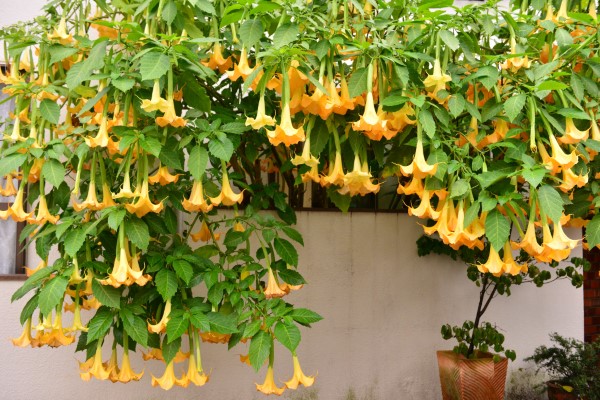back
How Dangerous is Datura & Is it Poisonous?
Jan 28, 2020

What Is Datura?
Datura is a flowering plant often used in ornamental gardens for the beautiful pastel trumpet-shaped flowers it produces. Datura is a genus with between nine and twelve species under its umbrella. As part of the nightshade family, it has been part of religious and cultural rituals for thousands of years, especially in ancient Chinese medicine. The plants grow to about three feet tall all over the world in tropical and moderate climates. Datura seeds develop inside a capsule covered in spines; as it ripens, it splits open and distributes the seeds onto the ground. Read on with MHS below:
Also known as Jimson Weed, moonflower, devil’s weed, or thornapple, Datura is a poisonous plant that is unfortunately often abused for recreational use because it produces hallucinations and intoxication that can last for days. Users may ingest the Datura, smoke it, or use it as a lotion on the skin. Sadly, many people die of Datura overdoses because it is so easy to misjudge how much of the drug you’re taking. As little as 15 grams of Datura, which is between 15 and 25 seeds, can be a fatal dose. The side effects on the body can last long after the “high” wears off.
Hyoscyamine, atropine, and scopolamine give Datura its intoxicating and medicinal properties.
- Hyoscyamine is a treatment for ulcers, irritable bowel syndrome (IBS), pancreatitis, as well as other stomach troubles. Hyoscyamine can make you sleepy, cause headaches, or blur your vision, to name a few of the side effects.
- Atropine is a medication for digestive ailments, Parkinson’s disease, and heart problems, among others. Side effects may include but are not limited to headaches, nausea, difficulty in urination, and fever.
- Scopolamine, in the form of a prescription patch, is used to help with motion sickness. The side effects of scopolamine are similar to atropine and hyoscyamine. They include drowsiness, blurred vision, and confusion.
When these three chemicals are used separately under the supervision of a medical professional, side effects are controlled, and the drugs are generally safe. However, when used in combination as in Daturas, they are very dangerous and easy to overdose. The signs of an overdose include an inability to tell reality from fantasy, high body temperature, tachycardia, violent behavior, and pupil dilation.
What Are Some of the Effects of Datura?
Datura has a variety of physical effects on the human body.
Here are a few, but there are many more.
- Dilated pupils Dehydration
- High blood pressure
- Muscle cramps
- Hallucinations
- Restless leg syndrome
Mentally, Datura can cause amnesia, confusion, psychosis, and hallucinations, in addition to altering mood and emotional expression. If a person takes too much Datura but not enough to overdose, the consumer may still experience something similar to a hangover as the drug metabolizes. The individual may feel some anxiety, dehydration, sleepiness, and light sensitivity, as well as other symptoms.
Treating overdose usually involves using activated charcoal to prevent absorption of the drugs and intravenous physostigmine to cross the blood-brain barrier and calm aggravated receptors. However, this antidote cannot be administered to those with heart problems and may only work temporarily, which is another reason that Datura overdose is so dangerous.
Datura Dosage
Datura dosage is traditionally determined based on the individual’s age, body strength, effects on appetite, severity, and condition of the patient. Hence it should be taken only after consulting with an experienced ayurvedic practitioner or doctor.
When taking Datura in any form there are several precautions that must be followed strictly such as avoiding taking large doses; taking it in small divided doses and not taking more than specified by a qualified practitioner or doctor. Taking too much datura could lead to serious health risks such as confusion, hallucinations, delirium, and respiratory depression. It is also important to drink plenty of water when consuming datura to help flush out any toxins from the body that may be accumulated due to overdosage. Due to its powerful sedative qualities, it should not be taken while driving or operating machinery until you have assessed your own reaction.
Risk Factors Of Datura
One of the major health risks associated with Datura is increased heart rate and irregular heartbeat, which could lead to dangerous cardiac arrhythmias if not controlled immediately. If a pacemaker is present in the patient, they should especially avoid any contact or ingestion of this plant as it can disrupt the pacemaker’s electrical signals and cause further complications. Glaucoma sufferers should pay attention to this risk factor as well because it has been linked to increased intraocular pressure in some patients. Pregnant women and lactating mothers are advised not to expose themselves or their babies to Datura due to the potential teratogenic effects of its alkaloid components on developing embryos and newborns respectively. For these reasons, anyone exhibiting caution towards these risks factors should take extra care when coming across this exotic species – contact with any part of the plant should be avoided at
One of the major health risks associated with Datura is increased heart rate and irregular heartbeat, which could lead to dangerous cardiac arrhythmias if not controlled immediately. If a pacemaker is present in the patient, they should especially avoid any contact or ingestion of this plant as it can disrupt the pacemaker’s electrical signals and cause further complications. Glaucoma sufferers should pay attention to this risk factor as well because it has been linked to increased intraocular pressure in some patients. Pregnant women and lactating mothers are advised not to expose themselves or their babies to Datura due to the potential teratogenic effects of its alkaloid components on developing embryos and newborns respectively. For these reasons, anyone exhibiting caution towards these risks factors should take extra care when coming across this exotic species – contact with any part of the plant should be avoided unless under the care of a qualified practitioner or doctor
How Can I Learn More About Datura?
If you would like to learn more about Datura, contact us at MHS for an appointment. We can help if you or someone you love is struggling with an addiction to Datura or a related derivative. People who use Datura may also be using other harmful substances, so overcoming a Datura addiction should be done under appropriate medical supervision. At MHS, we work with individuals and groups from adolescence to adulthood in both educational and treatment programs.
Common Names Of Datura Plant
Datura, a flowering plant native to many parts of the world, has a wide variety of common names. Due to its presence in Jamestown, Virginia, it is sometimes called Jamestown weed or Stramonium jimsonweed. Other parts of the United States refer to it as Purple thorn apple, Hell’s bell, Devil’s snare, Stinkweed, Jimsonweed, or Mad apple. In the southern parts of North America, it is commonly referred to as Moonflower or False castor oil. Its visibility across many cultures has led to it being known by various other names such as Devil’s apple or Devil’s cucumber in much of the Americas and Europe; Prickly burr throughout Southeast Asia; and finally Ummetta in Telugu and Dhuttura Kanaka or Ummattangani in Tamil from India.
Although Datura is such a widely known flower with so many different names attributed to its presence around the world for thousands of years, Indians recognize it mainly as Sada Dhaturah (Hindi) and Dhattura (Bengali). Its use grew so steadily that traditional recipes began incorporating extracts from various parts of the flower as popular.
The Pharmacological Compounds in Datura
The pharmacological constituents of Datura are credited with its powerful hallucinogenic and deliriant properties. It contains a vast array of antioxidants, flavonoids, alkaloids, organic compounds, and minerals that each offer therapeutic value. The key bioactive components present in Datura include Daturine, Daturadiol, Hyoscine, and Atropine which are known for their medicinal effects in treating various illnesses such as asthma and asthma-related bronchitis. Other than these two major components, Datura also contains Noratropine, Fastudine, Allantoin, Hypocyamine, Norhyosciamine, and Tropane which are utilized to treat motion sickness as well as seizures before surgery. Furthermore, the plant also contains Meteolodine, Scopolamine, and Mucilage along with albumin. Other nutrients present in the herb include Vitamin C and minerals such as niacin and malic acids which all help support overall health.
These properties make this herb an important part of traditional medicine across many cultures because of its wide range of potential applications ranging from relieving pain to managing more serious conditions like depression. With its diverse phytochemical components, it is no wonder why D
Parts Of Datura Used In Medicinal Formulations
The Datura plant is a powerful medicinal herb with many healing properties. It can be used in the form of fresh or dried leaves, fruits, roots, and seeds. For centuries, it has been used as a traditional medicine in many cultures all over the world for its anti-spasmodic, analgesic, sleep-inducing, expectorant, sedative, and hypnotic properties. Additionally, it can also act as an intoxicant, uterine stimulant, and bronchodilator when consumed in proper dosage. You can learn more about Datura with Our DBT program.
Despite its wide range of medical benefits, however, one must exercise extreme caution while using the parts of this plant for medicinal formulations. The danger lies especially in the raw use of datura seeds which are extremely poisonous and so require a proper purification process to reduce their toxicity levels before they can be consumed safely. This sophisticated process detoxifies the harmful effects of the seeds so that they can retain their therapeutic value when incorporated into any formulations and treatments.
Image Credit: magicflute002/ Getty Images

